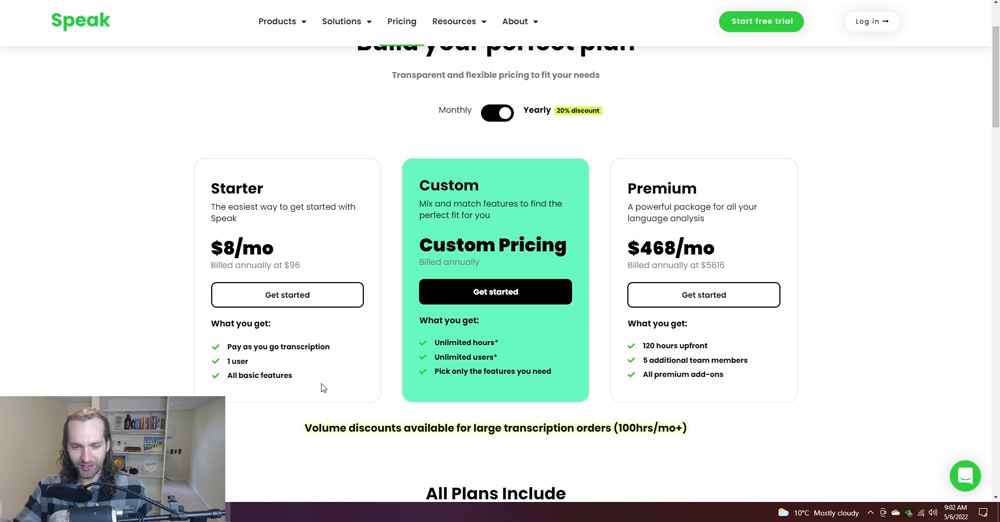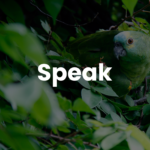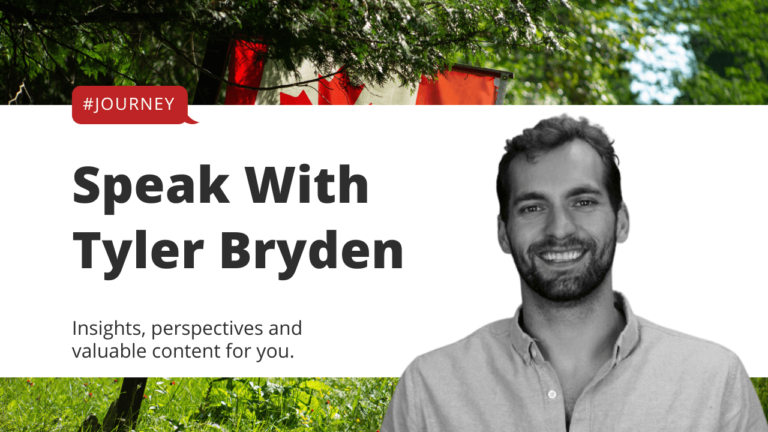Daily Standup 15
- Continued Experiments With Pricing
- Freemium vs Free Trial Model
- New Real-Time Custom Plan Builder
#saaspricing #freemium #freetrial #saas #conversionrateoptimization #buildinpublic #saasstartup #transcription #naturallanguageprocessing
Resources
https://app.speakai.co/pricing
https://www.techto.org/events/ptp-may-6
Automated Transcription
Hello hello Tyler Bryden here. Thank you so much for joining. I coming off a big poker night from Tech Stack TM. Thank you so much Brayden Evan for putting that on ton of fun. I had not played poker for a long time, so to be to be honest I was nervous. I was like, you know, am I going to be able to do this? I got through a first round, had a lot of fun at the table, a little bit of a patient slow moving table and then moved into round two where I had a rambunctious table. Had a lot of fun with stacking some chips until the very last hand and lost to it’s good hand myself. But anyways. I’m buzzing from it with tough to fall asleep tonight. I’m thinking about it this morning still and definitely was great to see all these people. Probably 80 people there, networking, having fun flipping over tables. OK, there’s no flipping over tables, but just some friendly competition all for charity. And yeah, just just grateful that they put that on and I had a chance to connect back with in person with the community there with that part of it was connected to tech to some great sponsors who are there pitching today at.
I think at lunchtime 12:00 PM Eastern Standard Time perfecting the pitch, we’ll see how that goes. They’ll be some investors given some feedback, and then some people in the crowd saying, hey, I would invest in this. I would not. So I got to go up. I got to show up with a smile, got to be excited and do a good job. Being precise with what we are doing here at speak, AI getting closer and closer to that. And obviously when we deal with some of the technologies that we’re dealing with, that’s not always the easiest thing, but it’s important as you continue to work through to distill.
The message in the simple, most meaningful way and something I continue to to work on. So besides that, what I want to talk about today was this ongoing journey which has been basically experimenting with pricing, and this started early on in my career as an agency owner where I originally started billing per hour, which is very standard. Pretty predictable, nice way to build projects and understand them, and then as I moved into managing Google ads. Google grants you started to have this relationship where you were creating a lot of value. Even if you weren’t necessarily spending a ton of time on it and the expertise that you had built had sort of compounded and allowed you to make decisions or make bulk edits to these accounts, which would then significantly improve their performance, and that wouldn’t take you know 10 hours to do. You could do that in 15 minutes, but the value was there and so the relationship with pricing started to change during that.
And that then continued as a journey with speak AI and originally I mean a goal of mine had always been. How can I? How can we democratize access to these technologies, which a lot of times are limited to large companies, technical elite developers, data scientists and I felt this sort of ambition to help other people do it. And that was a challenge I had with myself. I had wanted to transcribe. I had wanted to analyze.
I wanted to visualize. I’d wanted to build sort of reports, but I didn’t necessarily have the technical knowledge. I wasn’t that good at Python. I wasn’t that good at our. There were my own technical gaps were not allowing me to have access to some of the insights I want, and some of the capabilities that I wanted. So a lot of it was solving my own problems. 1st and I knew that there were other people like me out there and that’s been validated over and over again as we’ve continued our business, and so we actually started with basically a freemium.
Motto where you could where you could come. You could sign up for speak and you could use the service basically completely free and I believe we had some hours included in that. And when we conclude hours in our account, you know there’s an actual hard cost to us. You upload an hour of audio and video, there’s storage. There’s transcribing, there’s analysis all that runs together and then say you stream that file back.
A bunch. There’s a cost there for us, so there was a charitable aspect to us, but I think the biggest thing that we realized was. When you have a freemium trial, depending on how you’re building product, the pain points the need there aren’t these time based triggers that then. Drive someone to then sign up So what we were finding was because there was free there was allowing to do a bunch of actions in the application, some of them that were valuable, some that were maybe not necessary or part of the workflow or use case of that customer. There was no real incentive to sign up and no ramification to not signing up for a plan and felt that a little bit last night just as a parallel on the poker table because we didn’t increase big and small blinds and so you could not have to play a hand and there was no real risk.
And so I think what happens is that you need to build an incentive, and so that’s when we switch to free trial. And as do a really scary time at this because we didn’t know if we had proved the value of the platform. We didn’t know if it was useful enough. We had obviously seen validation and insights and paying customers, but there was still a lot of work for us to have that confident jump. And what happened was once we put that free trial in then there was all the sudden we started seeing more signups and.
And I mean paid signups and it’s because there is this time based. Mechanism in it and we did 14 days. We did a lot of looking at the best length of trial and we saw things from you know 30 days to 14 days to seven days later down the middle with 14 days. A lot of best practice recommending that and that’s something that we found. A charitable enough time where they get to use the platform to its full extent not feel chinci say a 7 day free trial but then the 30 day is just too long of a period to create any action and so that was really a pretty big realization for us as we went along the journey.
About these time based triggers and then the sort of urgency and incentive that that is created. Not always perfect. We have a lot of people who are coming through for say simple use cases and the the platform in sort of its full vastness and complexity is not necessarily fully relevant to them and so they’ll use some small services. Or maybe they’re even doing one one time transcribes one time analysis one time export to PDF. Whatever it is that they’re doing, and then we don’t see them go to a subscription. But generally that change.
Was for the better and we saw positive growth. Month over month because of it. And again, something really surprising. Something very exciting to be honest. So if you’re looking at this freemium model versus free trial model I, you know I encourage you to at least look at the merits of a free trial because it’s great to have a bunch of users on your platform. And when you say hey free, don’t pay for anything, a plan. It’s great because people will sign out. There’s less risk. However they might not be customers that never confirmed. And of course, depending on your business model, that could be good. You just have users, especially if they’re active.
Is there some other cases not? I wouldn’t use the term dead weight, but they are not users who are going to become customers. And really, they’re just a vanity metric that shows that your free trial to you know your your conversion rate to subscription plan is actually quite low, so you’re trying to qualify users who are get into the system and the question that you ask yourself is what I rather have a high. You know top level 20,000 users or what. I’d rather have only 5000 users, but 3000 are paying subscription plans in the other ones.
In you know a process of trying it out and then converting, so that’s something that we had to deal with and work through, and I learned a lot along the way. The one other really nice intricacy that we have. We didn’t actually put in was this idea of when you sign up. Should you be adding your credit card, and I think what happens there is you do decrease the sign up. You create a lot of friction on the sign up. A lot of people are skeptical and haven’t tested the platform out, but then the chance that you were likely to convert.
And because they made that commitment is much higher and so we went chose to go without the credit card upon entry. And that’s been good. But that could be a mechanism that we put in place moving forward. To qualify. However, I think because of the way we built the platform, it’s nice for people to test it out. We’re confident that the product is great, and so it does not that much of a risk for us to not ask for the credit card. We’d rather people have the experience and then.
At the end of last year, after I think we launched our free trial in July 2021, we moved through and we said. Basically Jan 2020 started. We said OK, we want to accelerate this. We want to expedite this process even more and because we are seeing different use cases come through in many cases some of them education, some from marketing and research firms, some from people who are just say doing transcriptions of earning costs or things like that. We started to see that there were patterns of stacks of basically account configurations and then the amount of say hours or team members that they were actually using that were most valuable.
To them and sometimes. The sort of structured plans that we had set up were not jeopardizing that, but it was giving people this feeling that they were paying for things that they were not using, and what we really wanted to do was make sure that they felt that the value was there, that they were getting the best bang for the buck that they were getting a deal. It was a win win for everyone, and there was lots of value creation, so we started to move towards this personalized plan model and I think I’ll talk quickly about this before, but it was very simple stack. It was someone comes to a page to say. It’s a jot form. We asked them what they need. How many team members? How many hours? What features are they interested in? Don’t like the term features? Use the term solutions and they click click click and then it builds up a little Google sheet for us. We then build that a nice little plan offering a Google doc. Send that over through a doc send file and give them say 14 days to take that offer which generally is a discount and a pretty nice discount that that makes them feel like it’s a win. It is a win for for them it’s a win for us and they can choose to then.
Accept that plan and we’ve seen a lot of people not only accept the monthly plan, but also choose an annual plan and then more than that, say thank you. So that was an exciting shift for us. After you know a little, you know quite a while of sort of banging head against the wall trying to figure out the best way to optimize pricing. And so then the goal was, how can we make this a little bit better? And that brings us to our last variation, at least for now, which is sort of this new build your perfect plan idea. And So what we did is have.
Basically two small preset configurations that we’ve seen used quite quite often from some more, say personal, not pay as you go, but you know just individual users who have a small amount of things that they’re doing and that could be just a starter kit with a couple features that you want. And then that gets you going in the platform and then say you have a a volatile amount of hours that you’re trying to transcribe and analyze each month. Then you can just pay per minute. For that you don’t have to worry about that cost being built in and you not. Using the hours that you’re paying for it, which is something that we saw and we saw, people have their own sort of waves of how many hours that they were doing on a per project basis and stuff, but they needed to retain that data and keep that data. So we gave that option and then we moved into a little bit more of a a premium package, which is what we’ve seen larger teams take, which is a bunch of hours.
Some team members and then printing them add ONS and those premium add-ons we’ll talk through in a second, but like you know, premium exports ways to share ways to customize and everything there, and so we have. Basically what all plans include still working on the best way to show us some frequently asked questions. And then this idea of custom, so starter doesn’t fit or premium doesn’t fit or you want to make some slight adjustments on either. Then you can jump into the plan. There is this monthly yearly shift that’s great and 20% discount on that. It then drives you to sign up for the plan and now you have the actual pricing. The sort of real time custom plan builder. And this is something we’re really excited about. A lot of conditions, a lot of discussions over this and there could be this idea that we’ve chosen too many too many.
Variables, so that’s something that we’re sort of interested to see, but even for us we decided, hey, we don’t you know if you want to sign up for three months because you’re in a deep research project and you want to start and get on a trial, go ahead. You can do that. You get 5% off. You can see how much you can save. You get the hours up front instead of the hours dripping out each month, and then that allows you to make an investment in the platform and really have no risk. And really, it’s as easy as that. I can hop into monthly, as I’ve got my custom plan. I want to do 10 hours.
I want to do 25 team members. Oh thank you big team. And then I’ve got all my sort of premium add-ons that I can then add to the account each with sort of their own monthly cost. Custom categories and insights, and I won’t. I won’t go line line by line and I’m already running out of time, but you can then build these in and say, OK, I want this. I want this. You get your total plan. It’s going to be 385 a month but if I hop into yearly you can see that you save 1000 bucks is 20% off. And as we announced this week, there’s also an affiliate.
Plan so if you someone shares an affiliate with you and then you can get 10% off the actual premium add-ons as well too, we think that’s a great deal. You get all the hours up front, you get the team capabilities and you have in a very advanced, basically fully customized white label version of speak. I can jump and click a couple of these off and then you see the price adjusted in real time. You can now see that that the price is there and then at a state if you want to upgrade or degrade or downgrade, you can easily do that. Using this mechanism, and so definitely a little bit different, we’ve been very transparent, tried to be customizable with our pricing and this is released literary. Just yesterday we announced it in our monthly email and are now excited to see people sort of experimenting with this, building their own plans. We did move to a user model which would then you know, as you add more users 5 bucks a month on four month, 4 bucks a month annually. So a couple different mechanisms that we’re experimenting and trying out.
I’m coming up at the end of my time, but just think of pricing as an ongoing journey, something that we didn’t think about enough. We thought about this rigorous rigid sass plans that everyone is perfect for these buckets. That is not true. Everyone is individual. Everyone needs certain things. If you can accommodate that, not only will you grow your your customers will be really happy and thank you for their your willingness to work with them, so I hope there was some good insights there. This has been a fun journey and excited to share some more results as we move forward with pricing.
Thank you.




